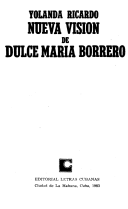4.1.1.4 The poetic work of Dulce María Borrero (1883 – 1945)

Dulce María Borrero was one of Esteban Borrero Echevarría’s daughters, and from a young age she was surrounded by an environment conducive to literary creation. Her entire family moved to Key West in 1895, where she published her first poems in “Revista de Cayo Hueso.”
In the Republic, his literary career began with the award he won at the 1908 Havana Athenaeum Floral Games. In 1912, he published his only collection of poems, “Hours of My Life,” which was published in Berlin. This work earned him first prize and the gold medal from the National Academy of Arts and Letters.
The collection of poems consists of eight sections, with the subtitles: “Drops of Tears,” “Reminiscences,” “Bloody Laurels,” “Flowers of Love and Melancholy,” “Distant Dawns,” “The Sowing of Death,” “Love,” and “Twilight Hours.” These allow us to infer that this is a work inherited from the Romantic imprint of the 19th century; although at times the author takes refuge in an expressive detachment not entirely in keeping with this trend.
The fundamental theme is love, from the perspective of separation, not only abandonment but also death; in this sense, his treatment of this topic is somewhat reminiscent of Casal and is linked to the connection of modernism to the 20th century, without sharing the innovative conception of Boti or Poveda, mainly because he did not systematically dedicate himself to literary creation.
A fine sensitivity and sometimes eroticism that escapes from deeply rooted social conceptions and religious dogmas transpires in his verses, with a lyricism that is perhaps hackneyed but saved by its authenticity: “And I dream such sweet things, / and I dream of so many pleasures, / that I forget your soul / to dream of your kisses!”
Her emotionality and feminine perception of reality are evident in almost all of her verses, in which, through a deepening of her own personality—perhaps autobiographical in regard to love—she manages to capture her essence and communicate at a high level with her readers, producing a kind of empathy that outlives the text.
His particular sensitivity is also evident in his relationship with his homeland, stripped of its political meaning and perhaps returned to its primary sense of homeland, the earthiness of belonging to the Island, and his relationship with the people who, in some way, shaped it. In this sense, he dedicates a poem, entitled “Without a Name,” to José Martí.
Dulce María Borrero was preparing a volume that never saw the light of day, titled “Watercolors,” for which the texts and references have been lost, except for one of the poems entitled “The Duchess’s Pity,” along with an introductory fragment. She later published some verses in contemporary magazines. She contributed to “Cuba Contemporánea,” “Revista Cubana,” “Revista Bimestre Cubana,” “El Fígaro,” “Cuba y América,” “Social,” “La mujer moderna,” and “Anales de la Academia Nacional,” among others.








